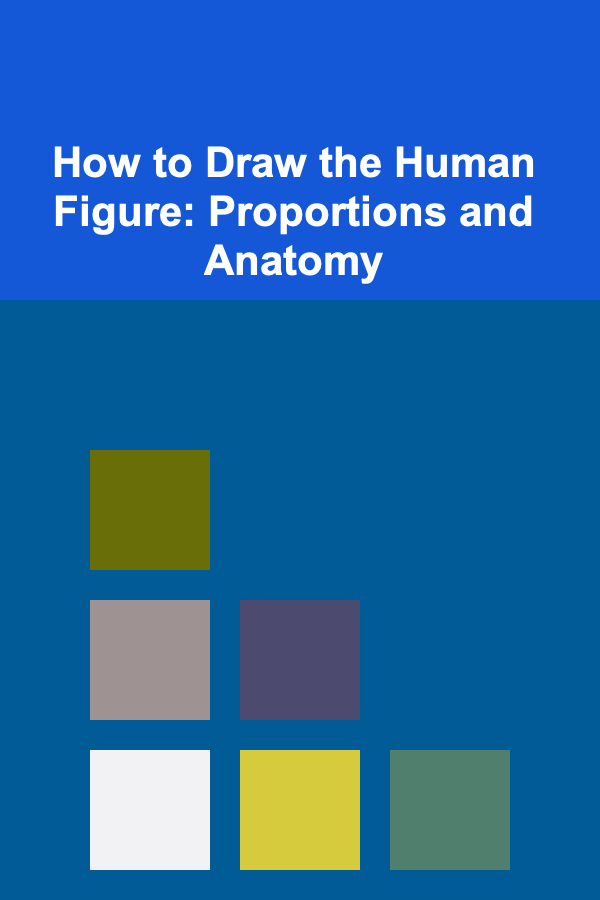
How to Draw the Human Figure: Proportions and Anatomy
ebook include PDF & Audio bundle (Micro Guide)
$12.99$8.99
Limited Time Offer! Order within the next:

Drawing the human figure can be an incredibly rewarding and challenging endeavor for any artist. It involves not only understanding the proportions of the human body but also an intricate knowledge of human anatomy. With practice, patience, and a good understanding of the key concepts, anyone can improve their ability to draw the human form with accuracy and fluidity. This article will explore the essential elements of human figure drawing, focusing on proportions and anatomy, and how to approach this foundational aspect of art.
Understanding the Basics of Human Proportions
One of the first steps in learning how to draw the human figure is to understand its proportions. While every person's body is unique, artists rely on a set of standard guidelines to represent the average proportions of a human body. These guidelines provide a framework for achieving a more natural, realistic appearance when drawing.
The "Eight Head" System
The eight-head system is a traditional method used to establish the proportions of a human body. This method divides the human body into eight equal units of length, each represented by the size of the head. It's based on the idea that the average adult body can be measured by stacking eight head lengths from the feet to the top of the head.
- The Head: The top of the head marks the first unit.
- Neck to Shoulders: The second unit ends around the shoulders.
- Arms and Hands: The arms are usually represented by two and a half head lengths, and hands will end slightly below the waist.
- Torso and Hips: The torso, from the waist to the shoulders, is roughly two and a half head lengths.
- Legs: Legs make up about half the total height of the body, or four head lengths.
- Feet: The feet will end slightly below the final head length.
These eight divisions help create a proportional model for the body, serving as a useful guideline when drawing any figure. While these guidelines are widely used in classical figure drawing, they can be adjusted for artistic style or to represent particular types of bodies (e.g., tall, short, muscular, or slim).
Variations in Proportions
While the eight-head system is useful, it is important to note that there is no "one-size-fits-all" standard for human proportions. For example, shorter individuals may have fewer head-lengths in their total height, and taller individuals may have longer legs, which will affect the overall proportions.
Additionally, artistic styles can exaggerate proportions for expressive or stylistic purposes. For instance, cartoon figures often have larger heads and shorter limbs, while certain character types in animation or comic books may have elongated limbs for dramatic effect. Understanding proportions gives you the ability to modify them deliberately for these purposes.
Studying Human Anatomy: Muscles and Bones
Once you've grasped the basics of proportions, it's time to study the anatomy of the human body. Anatomy refers to the internal structure of the body, including bones, muscles, and joints. This knowledge helps artists create more accurate, lifelike depictions of the human figure. The human body is complex, but with an understanding of the major muscles and bones, you can greatly enhance the quality of your drawings.
The Skeleton: Building the Framework
The first step in understanding human anatomy for drawing is the skeletal structure. The skeleton provides the foundation on which muscles and other tissues are attached, and it gives the body its basic shape and structure. Understanding the skeleton is crucial because it helps you visualize the overall shape of the body and understand how the body moves.
- Skull: The skull forms the top of the body and is the starting point for any figure drawing. The position and shape of the skull impact the placement of other features such as the neck, shoulders, and torso.
- Spine: The spine is the central axis of the body and supports the head and torso. The curvature of the spine, especially in the lower back and neck, affects posture and balance.
- Ribcage: The ribcage provides protection for vital organs like the heart and lungs. The ribs influence the shape of the torso, and understanding their placement will help you create a more accurate upper body.
- Pelvis: The pelvis plays a significant role in the alignment and movement of the lower body. The pelvis connects the spine to the legs and supports the body's weight while standing or walking.
Muscles: Adding Volume and Expression
While bones provide the framework, muscles add volume and complexity to the body. Understanding how muscles function and are distributed throughout the body will help make your drawings more dynamic and lifelike.
-
Major Muscle Groups:
- Deltoids: These muscles cover the shoulders and give the upper arms their rounded shape.
- Biceps and Triceps: The biceps (front of the upper arm) and triceps (back of the upper arm) are responsible for the movement of the arms and contribute to their shape.
- Pectorals: The pectoral muscles are located in the chest, and they help with the movement of the arms.
- Abs (Rectus Abdominis): The abdominal muscles give the torso shape and assist in bending and twisting motions.
- Quadriceps and Hamstrings: These muscles in the upper leg allow for movement such as squatting and running.
- Calves: The calf muscles provide propulsion when walking or running.
-
Muscle Definition: Muscles create the definition in the body. Understanding their shape and how they interact with the bones and joints is essential to drawing the human body. Pay attention to how the muscles stretch, contract, and create shadows, which add volume and depth to your drawings.
-
Dynamic Movement: Muscles are responsible for movement, and the way they stretch and contract is integral to depicting action. When drawing the human figure in motion, the muscles will shift and change shape. Focus on how the muscles react to movement and how they contribute to the figure's overall pose and energy.
Joints and Flexibility
Joints are where two or more bones meet, and they allow for the movement of the body. There are different types of joints in the body, including ball-and-socket joints (like the shoulder and hip), hinge joints (like the knee and elbow), and pivot joints (like the neck). Understanding the range of motion at each joint is essential for drawing the human body in different poses and movements.
- Elbow and Knee: These hinge joints allow for bending and extending the arms and legs.
- Shoulder and Hip: Ball-and-socket joints allow for a wide range of movement in the arms and legs, including rotation and swinging.
- Fingers and Toes: These smaller joints have more limited movement but are crucial for balance and coordination.
Understanding the movement of joints and how they affect the body's pose is critical when drawing the human figure, especially when working on dynamic, action-filled poses.
Drawing the Human Figure in Action
Once you have a strong grasp of the proportions and anatomy of the human body, you can move on to drawing the figure in action. This step challenges you to depict movement, energy, and emotion in your figures.
Gesture Drawing
Gesture drawing is an essential exercise for artists who wish to capture the human form in motion. The goal is not to focus on fine details but to quickly sketch the overall pose, energy, and flow of the body. Gesture drawings help loosen up the artist and emphasize the movement rather than the static elements of the figure.
To practice gesture drawing, start by drawing quick, loose sketches of people in action. Use simple shapes (like ovals and lines) to represent the head, torso, arms, and legs. Focus on the flow of the body and the main angles of the pose. The aim is to capture the energy of the pose, not the precision of anatomy.
Working with Proportions in Action
When drawing the human figure in motion, it's crucial to maintain correct proportions while exaggerating movement. The dynamic tension created by bending joints or stretching limbs may temporarily alter the body's proportions. However, the underlying structure of the figure should remain consistent.
For example, when a figure reaches for something high, the arms may appear longer, but the overall proportion of the body should still reflect the original eight-head measurement. The key is balancing realism with expression. Practice drawing people in different poses, including standing, sitting, running, and jumping, while keeping proportions and anatomy in mind.
Using Perspective in Figure Drawing
Perspective is another crucial aspect when drawing the human figure in various poses. The body changes in appearance depending on the viewpoint. For example, when viewing a figure from above, the legs may appear shorter, while a figure viewed from below will show more of the underside of the body.
Perspective drawing helps add depth and dimension to your figure drawings. It is essential to adjust the proportions of the body based on the angle and distance from which the figure is viewed. This skill will allow you to create more dynamic, three-dimensional representations of the human form.
Conclusion
Mastering the art of drawing the human figure requires a deep understanding of proportions, anatomy, and movement. By learning the basic structure of the body, including the skeletal framework and muscle groups, you will be able to create more realistic and dynamic representations. However, it is also important to practice observing the human body in real life and experimenting with various poses and perspectives.
Through continuous practice, experimentation, and observation, you can develop your own unique style while still respecting the fundamental principles of proportion and anatomy. Whether you're drawing the human figure for artistic exploration, animation, or portraiture, understanding the body's proportions and anatomy will provide you with the tools needed to create compelling and accurate depictions of the human form.

How to Create a Home Office that Boosts Productivity
Read More
How to Establish a Work-Life Balance in Your Home Office
Read More
How to Overcome Financial Stress and Stay on Track
Read More
How to Set Financial Goals for Your Home and Achieve Them
Read More
Tech Tools Every Job Seeker Should Use
Read More
The Customer Insights Analyst's Guide: Unlocking the Power of Consumer Data
Read MoreOther Products

How to Create a Home Office that Boosts Productivity
Read More
How to Establish a Work-Life Balance in Your Home Office
Read More
How to Overcome Financial Stress and Stay on Track
Read More
How to Set Financial Goals for Your Home and Achieve Them
Read More
Tech Tools Every Job Seeker Should Use
Read More